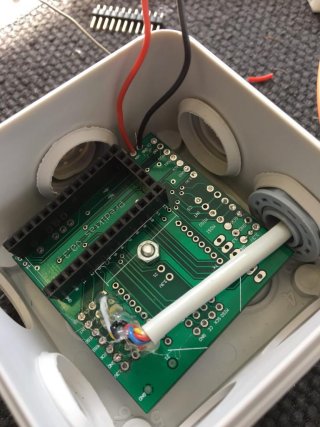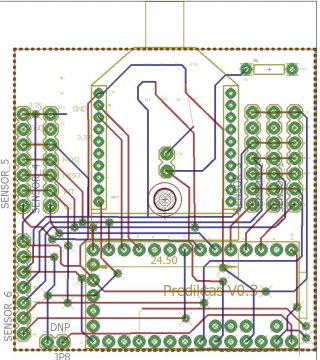I have designed a quick prototype with a teensy and accelerometer (MPU9250)
I have successfully put the teensy into hibernate mode, and i do get around 40uA when used alone (not plugged to the PCB).
When i power the PCB with the accelerometer and without the Teensy, i get 3mA.
When i plug the teensy on the PCB with the accel. and set it into hibernate mode, i get 78mA. ( i can see the variation of current from "awake" (108mA) to hibernate (78mA) mode )
i do not understand where this current leakage can come from.
I have heard unconnected pins can draw current, that's why i have set all unused pins to OUTPUT
Does anyone have an idea how i can reduce the power consumption to about 3mA ?

Unfortunately i have lost the original wiring, but the version below is quite close ( even though dirty...)

I have successfully put the teensy into hibernate mode, and i do get around 40uA when used alone (not plugged to the PCB).
When i power the PCB with the accelerometer and without the Teensy, i get 3mA.
When i plug the teensy on the PCB with the accel. and set it into hibernate mode, i get 78mA. ( i can see the variation of current from "awake" (108mA) to hibernate (78mA) mode )
i do not understand where this current leakage can come from.
I have heard unconnected pins can draw current, that's why i have set all unused pins to OUTPUT
Does anyone have an idea how i can reduce the power consumption to about 3mA ?
Code:
#include <Snooze.h>
#include "MPU9250.h"
#include "signal.h"
#include "filter.h"
SnoozeAlarm alarm;
MPU9250 Sensor_1(3);
#if defined(__MK20DX256__)
SnoozeBlock config_teensy32(alarm);
#endif
#define LED_BUILTIN (18)
#define NUMBER_SAMPLE 5000
#define ACQUISITION_FREQUENCY 4000.0
char data[12];
uint8_t size;
int i;
void setup() {
pinMode(0,OUTPUT);
pinMode(1,OUTPUT);
pinMode(2,OUTPUT);
pinMode(5,OUTPUT);
pinMode(6,OUTPUT);
pinMode(7,OUTPUT);
pinMode(8,OUTPUT);
pinMode(14,OUTPUT);
pinMode(15,OUTPUT);
pinMode(16,OUTPUT);
pinMode(17,OUTPUT);
pinMode(18,OUTPUT);
pinMode(19,OUTPUT);
pinMode(20,OUTPUT);
pinMode(21,OUTPUT);
pinMode(22,OUTPUT);
pinMode(23,OUTPUT);
Sensor_1.initMPU9250();
Sensor_1.getAres();
}
uint16_t getRMS(MPU9250 *sensor) {
float accelData[NUMBER_SAMPLE];
float filteredData[NUMBER_SAMPLE];
float filteredDataCached[NUMBER_SAMPLE-1000];
int16_t accelCount[1];
uint16_t i = 0;
long timer =millis();
uint16_t elapsed = millis()-timer;
while (i < NUMBER_SAMPLE && elapsed<2000) {
elapsed = millis()-timer;
if (sensor->readByte(MPU9250_ADDRESS, INT_STATUS) & 0x01)
{
sensor->readAccelData(accelCount); // Read the x/y/z adc values
accelData[i] = (float)accelCount[0] * sensor->aRes * 9.81 * 1000; // - accelBias[2];
i++;
}
}
if( elapsed<2000 ? false : true){
return 0;
}
filterType *filter = filter_create();
filter_init(filter);
filter_filterBlock(filter, accelData, filteredData, NUMBER_SAMPLE);
filter_destroy(filter);
for(int i=1000;i<NUMBER_SAMPLE; i++){
filteredDataCached[i-1000]=filteredData[i];
}
integrateSignal(filteredDataCached, accelData,NUMBER_SAMPLE-1000,1.0/ACQUISITION_FREQUENCY);
return RMS(accelData,NUMBER_SAMPLE-1000,1/ACQUISITION_FREQUENCY)*100;
}
void loop() {
uint16_t rms = getRMS(&Sensor_1);
data[0] = rms >> 8;
data[1] = rms & 0xff;
Serial.println(rms);
alarm.setAlarm(0, 20, 00); //hours, minutes, seconds
Sensor_1.Sleep();
Snooze.hibernate( config_teensy32 );// return module that woke processor
Sensor_1.initMPU9250();
}
Unfortunately i have lost the original wiring, but the version below is quite close ( even though dirty...)



